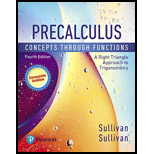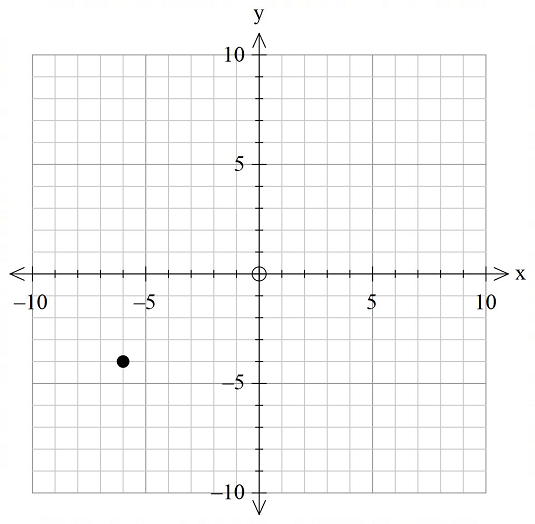
PRECALCULUS:CONCEPTS...-MYLAB+ETEXT
4th Edition
ISBN: 9780135874738
Author: Sullivan
Publisher: PEARSON
expand_more
expand_more
format_list_bulleted
Question
Chapter B.1, Problem 4E
To determine
The coordinates of the points shown below. Also describe in which quartile the point lies by assuming that the coordinates are integers.

Expert Solution & Answer
Want to see the full answer?
Check out a sample textbook solution
Students have asked these similar questions
Does the series converge or diverge
Does the series converge or diverge
Diverge or conver
Chapter B Solutions
PRECALCULUS:CONCEPTS...-MYLAB+ETEXT
Ch. B.1 - Prob. 1ECh. B.1 - Prob. 2ECh. B.1 - Prob. 3ECh. B.1 - Prob. 4ECh. B.1 - Prob. 5ECh. B.1 - Prob. 6ECh. B.1 - Prob. 7ECh. B.1 - Prob. 8ECh. B.1 - Prob. 9ECh. B.1 - Prob. 10E
Ch. B.1 - Prob. 11ECh. B.1 - Prob. 12ECh. B.1 - Prob. 13ECh. B.1 - Prob. 14ECh. B.1 - Prob. 15ECh. B.1 - Prob. 16ECh. B.2 - Prob. 1ECh. B.2 - Prob. 2ECh. B.2 - Prob. 3ECh. B.2 - Prob. 4ECh. B.2 - Prob. 5ECh. B.2 - Prob. 6ECh. B.2 - Prob. 7ECh. B.2 - Prob. 8ECh. B.2 - Prob. 9ECh. B.2 - Prob. 10ECh. B.2 - Prob. 11ECh. B.2 - Prob. 12ECh. B.2 - Prob. 13ECh. B.2 - Prob. 14ECh. B.2 - Prob. 15ECh. B.2 - Prob. 16ECh. B.2 - Prob. 17ECh. B.2 - Prob. 18ECh. B.2 - Prob. 19ECh. B.2 - Prob. 20ECh. B.2 - Prob. 21ECh. B.2 - Prob. 22ECh. B.2 - Prob. 23ECh. B.2 - Prob. 24ECh. B.2 - Prob. 25ECh. B.2 - Prob. 26ECh. B.2 - Prob. 27ECh. B.2 - Prob. 28ECh. B.2 - Prob. 29ECh. B.2 - Prob. 30ECh. B.2 - Prob. 31ECh. B.2 - Prob. 32ECh. B.3 - Prob. 1ECh. B.3 - Prob. 2ECh. B.3 - Prob. 3ECh. B.3 - Prob. 4ECh. B.3 - Prob. 5ECh. B.3 - Prob. 6ECh. B.3 - Prob. 7ECh. B.3 - Prob. 8ECh. B.3 - Prob. 9ECh. B.3 - Prob. 10ECh. B.3 - Prob. 11ECh. B.3 - Prob. 12ECh. B.5 - Prob. 1ECh. B.5 - Prob. 2ECh. B.5 - Prob. 3ECh. B.5 - Prob. 4ECh. B.5 - Prob. 5ECh. B.5 - Prob. 6ECh. B.5 - Prob. 7ECh. B.5 - Prob. 8ECh. B.5 - Prob. 9ECh. B.5 - Prob. 10E
Knowledge Booster
Learn more about
Need a deep-dive on the concept behind this application? Look no further. Learn more about this topic, calculus and related others by exploring similar questions and additional content below.Similar questions
- Can you help explain what I did based on partial fractions decomposition?arrow_forwardSuppose that a particle moves along a straight line with velocity v (t) = 62t, where 0 < t <3 (v(t) in meters per second, t in seconds). Find the displacement d (t) at time t and the displacement up to t = 3. d(t) ds = ["v (s) da = { The displacement up to t = 3 is d(3)- meters.arrow_forwardLet f (x) = x², a 3, and b = = 4. Answer exactly. a. Find the average value fave of f between a and b. fave b. Find a point c where f (c) = fave. Enter only one of the possible values for c. c=arrow_forward
- please do Q3arrow_forwardUse the properties of logarithms, given that In(2) = 0.6931 and In(3) = 1.0986, to approximate the logarithm. Use a calculator to confirm your approximations. (Round your answers to four decimal places.) (a) In(0.75) (b) In(24) (c) In(18) 1 (d) In ≈ 2 72arrow_forwardFind the indefinite integral. (Remember the constant of integration.) √tan(8x) tan(8x) sec²(8x) dxarrow_forward
- Find the indefinite integral by making a change of variables. (Remember the constant of integration.) √(x+4) 4)√6-x dxarrow_forwarda -> f(x) = f(x) = [x] show that whether f is continuous function or not(by using theorem) Muslim_mathsarrow_forwardUse Green's Theorem to evaluate F. dr, where F = (√+4y, 2x + √√) and C consists of the arc of the curve y = 4x - x² from (0,0) to (4,0) and the line segment from (4,0) to (0,0).arrow_forward
- Evaluate F. dr where F(x, y, z) = (2yz cos(xyz), 2xzcos(xyz), 2xy cos(xyz)) and C is the line π 1 1 segment starting at the point (8, ' and ending at the point (3, 2 3'6arrow_forwardCan you help me find the result of an integral + a 炉[メをメ +炉なarrow_forward2 a Can you help me find the result of an integral a 아 x² dxarrow_forward
arrow_back_ios
SEE MORE QUESTIONS
arrow_forward_ios
Recommended textbooks for you
 Holt Mcdougal Larson Pre-algebra: Student Edition...AlgebraISBN:9780547587776Author:HOLT MCDOUGALPublisher:HOLT MCDOUGAL
Holt Mcdougal Larson Pre-algebra: Student Edition...AlgebraISBN:9780547587776Author:HOLT MCDOUGALPublisher:HOLT MCDOUGAL Mathematics For Machine TechnologyAdvanced MathISBN:9781337798310Author:Peterson, John.Publisher:Cengage Learning,Algebra & Trigonometry with Analytic GeometryAlgebraISBN:9781133382119Author:SwokowskiPublisher:Cengage
Mathematics For Machine TechnologyAdvanced MathISBN:9781337798310Author:Peterson, John.Publisher:Cengage Learning,Algebra & Trigonometry with Analytic GeometryAlgebraISBN:9781133382119Author:SwokowskiPublisher:Cengage

Holt Mcdougal Larson Pre-algebra: Student Edition...
Algebra
ISBN:9780547587776
Author:HOLT MCDOUGAL
Publisher:HOLT MCDOUGAL

Mathematics For Machine Technology
Advanced Math
ISBN:9781337798310
Author:Peterson, John.
Publisher:Cengage Learning,

Algebra & Trigonometry with Analytic Geometry
Algebra
ISBN:9781133382119
Author:Swokowski
Publisher:Cengage

Graph Theory: Euler Paths and Euler Circuits; Author: Mathispower4u;https://www.youtube.com/watch?v=5M-m62qTR-s;License: Standard YouTube License, CC-BY
WALK,TRIAL,CIRCUIT,PATH,CYCLE IN GRAPH THEORY; Author: DIVVELA SRINIVASA RAO;https://www.youtube.com/watch?v=iYVltZtnAik;License: Standard YouTube License, CC-BY